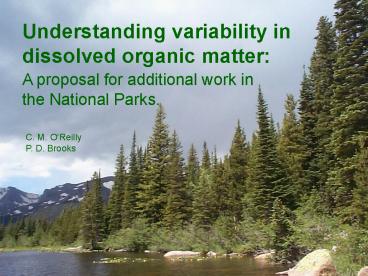Understanding variability in dissolved organic matter: - PowerPoint PPT Presentation
1 / 12
Title:
Understanding variability in dissolved organic matter:
Description:
Total DOC = labile DOC fulvic acids. food and. nutrients. aquatic. UV protection. soil OM ... Labile DOC. Higher altitude lakes have lower labile DOC (p .0135) ... – PowerPoint PPT presentation
Number of Views:208
Avg rating:3.0/5.0
Title: Understanding variability in dissolved organic matter:
1
Understanding variability in dissolved organic
matter
A proposal for additional work in the National
Parks.
C. M. OReilly P. D. Brooks
2
Why DOM is important?
- Buffer against acidification.
- Acid-base chemistry/ metal transport.
- Supports microbial production.
- Influences predator-prey interactions/ food web
structure. - Lake transparency/ stratification.
- Absorbs UV radiation.
3
Coarse breakdown of DOC
- Total DOC labile DOC fulvic acids
food and nutrients aquatic
UV protection soil OM
primary source
4
Patterns seen in Rocky Mountain NP. Total DOC
- Higher altitude lakes have lower total DOC
(plt.0041).
5
Labile DOC
- Higher altitude lakes have lower labile DOC
(plt.0135).
6
Fulvic acid concentration
- Higher altitude lakes have lower fulvic acid
(plt.0053).
7
fulvic acid
- fulvic acid is not related to altitude.
- fulvic acid is related to year (plt.0339).
- Most lakes are gt 50 fulvic acid.
8
BUT . . . . . . lots of variability!!
9
Temporal patterns differ spatially.
- Different ponds have different patterns of fulvic
acid concentration.
10
DOC model
VEGETATION Spatial control on soil organic matter.
CLIMATE Temporal control on hydrologic flow paths.
SOIL organic matter
hydrologic transport
WATER DOM
11
Which ecosystem characteristics are important in
controlling DOM?
2. What is the temporal variability of DOM in
different vegetation communities?
12
1. Which ecosystem characteristics are important
in controlling DOM?
- Landscape position
- headwater lakes vs. lakes lower in the catchment
- Climate/ snowmelt
- Vegetation patterns
- both watershed scale and riparian
- Soil type and chemistry































